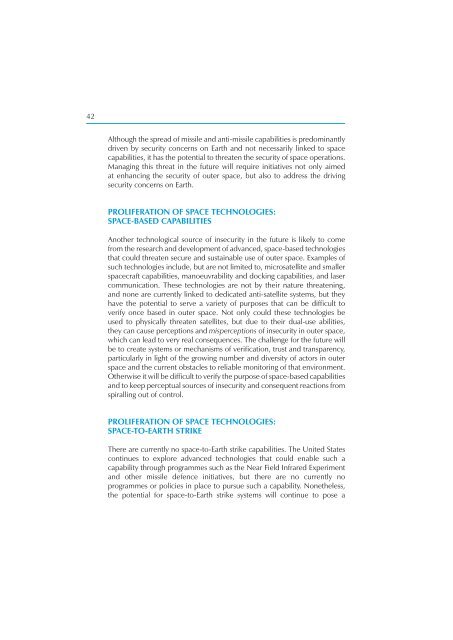Security in Space The Next Generation - UNIDIR
Security in Space The Next Generation - UNIDIR
Security in Space The Next Generation - UNIDIR
You also want an ePaper? Increase the reach of your titles
YUMPU automatically turns print PDFs into web optimized ePapers that Google loves.
42<br />
Although the spread of missile and anti-missile capabilities is predom<strong>in</strong>antly<br />
driven by security concerns on Earth and not necessarily l<strong>in</strong>ked to space<br />
capabilities, it has the potential to threaten the security of space operations.<br />
Manag<strong>in</strong>g this threat <strong>in</strong> the future will require <strong>in</strong>itiatives not only aimed<br />
at enhanc<strong>in</strong>g the security of outer space, but also to address the driv<strong>in</strong>g<br />
security concerns on Earth.<br />
PROLIFERATION OF SPACE TECHNOLOGIES:<br />
SPACE-BASED CAPABILITIES<br />
Another technological source of <strong>in</strong>security <strong>in</strong> the future is likely to come<br />
from the research and development of advanced, space-based technologies<br />
that could threaten secure and susta<strong>in</strong>able use of outer space. Examples of<br />
such technologies <strong>in</strong>clude, but are not limited to, microsatellite and smaller<br />
spacecraft capabilities, manoeuvrability and dock<strong>in</strong>g capabilities, and laser<br />
communication. <strong>The</strong>se technologies are not by their nature threaten<strong>in</strong>g,<br />
and none are currently l<strong>in</strong>ked to dedicated anti-satellite systems, but they<br />
have the potential to serve a variety of purposes that can be diffi cult to<br />
verify once based <strong>in</strong> outer space. Not only could these technologies be<br />
used to physically threaten satellites, but due to their dual-use abilities,<br />
they can cause perceptions and misperceptions of <strong>in</strong>security <strong>in</strong> outer space,<br />
which can lead to very real consequences. <strong>The</strong> challenge for the future will<br />
be to create systems or mechanisms of verifi cation, trust and transparency,<br />
particularly <strong>in</strong> light of the grow<strong>in</strong>g number and diversity of actors <strong>in</strong> outer<br />
space and the current obstacles to reliable monitor<strong>in</strong>g of that environment.<br />
Otherwise it will be diffi cult to verify the purpose of space-based capabilities<br />
and to keep perceptual sources of <strong>in</strong>security and consequent reactions from<br />
spirall<strong>in</strong>g out of control.<br />
PROLIFERATION OF SPACE TECHNOLOGIES:<br />
SPACE-TO-EARTH STRIKE<br />
<strong>The</strong>re are currently no space-to-Earth strike capabilities. <strong>The</strong> United States<br />
cont<strong>in</strong>ues to explore advanced technologies that could enable such a<br />
capability through programmes such as the Near Field Infrared Experiment<br />
and other missile defence <strong>in</strong>itiatives, but there are no currently no<br />
programmes or policies <strong>in</strong> place to pursue such a capability. Nonetheless,<br />
the potential for space-to-Earth strike systems will cont<strong>in</strong>ue to pose a








